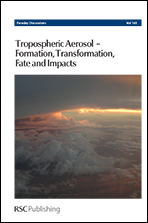Measurements of ambient organic aerosol indicate that a substantial fraction is highly oxidized and low in volatility, but this fraction is generally not reproduced well in either laboratory studies or models. Here we describe a new approach for constraining the viable precursors and formation pathways of highly oxidized organic aerosol, by starting with the oxidized product and considering the possible reverse reactions, using a set of simple chemical rules. The focus of this work is low-volatility oxidized organic aerosol (LV-OOA), determined from factor analysis of aerosol mass spectrometer data. The elemental composition and volatility of the aerosol enable the determination of its position in a three-dimensional chemical space (defined by H/C, O/C, and carbon number) and thus its average chemical formula. Consideration of possible back-reactions then defines the movement taken through this chemical space, constraining potential reaction pathways and precursors. This approach is taken for two highly oxidized aerosol types, an average of LV-OOA factors from ten field campaigns (average formula C10.5H13.4O7.3), and extremely oxidized LV-OOA (from Mexico City, average formula C10H12.1O8.4). Results suggest that potential formation pathways include functionalization reactions that add multiple functional groups per oxidation step, oligomerization of highly oxidized precursors, and, in some cases, fragmentation reactions that involve the loss of small, reduced fragments.
This article is Open Access
 Please wait while we load your content...
Something went wrong. Try again?
Please wait while we load your content...
Something went wrong. Try again?

 Please wait while we load your content...
Please wait while we load your content...